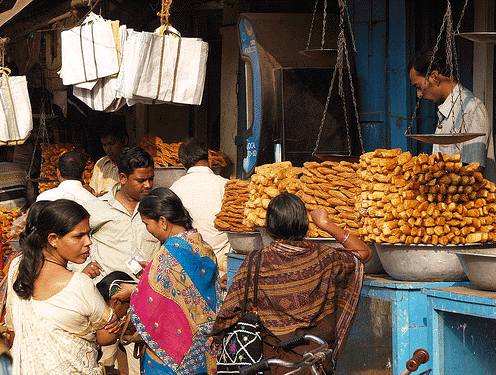Mahaprasad at Jagannatha Puri Temple, Part 3
BY: SUN STAFF - 21.6 2019

Lord Jagannatha's Snana Yatra Bathing Ceremony
The last in a three-part summary of Mahaprasad at Jagannath Temple.
During the 15-day period between Snana Purnima and Ratha Yatra (July 3rd), which we are currently in as of this writing, the Jagannath Deities are cloistered in Their sick room. They take no food, and are served only a cool drink called Pana. Pana is made by combining 1 cup of curd (yoghurt) with ½ cup sugar and 4 cups of water. On other festival days, bananas and raisins may be added to this sweet curd drink.
In Orissan homes, when devotees prepare to cook bhoga for offering to the Lord, the wife always takes bath before cooking, then offers puja while her sari is still wet. She reads from Bhagavad-gita or other sastra, then puts on another special sari worn only for cooking the rice meal to be offered to the Deities. Another sari must be put on if the cook needs to use bathroom facilities during the cooking process.
Just as devotees prepare foodstuffs for Krsna according to the instructions of the Acaryas, no garlic, onion or other unbonafide ingredients are used in cooking for Jagannatha Deities. Oriyans also forgo potatoes and tomatoes, which are considered to be "foreign" vegetables. At Jagannatha Temple, masala spices such as cardamom and clove are added only after the offering, as Mahaprasad is transported to Ananda Bazaar for distribution, in clay pots called kansa thalis.

Ananda Bazaar
Of course, no one leaves Jagannatha Puri Dham without taking Mahaprasad. Devotees can buy Mahaprasad at any time of the day at Ananda Bazaar, where some items are always available. Some preparations cost five rupees, while others may cost as much as fifty rupees. A combination of rice, dal and vegetable together costs about 35 rupees, and serves as a main meal.
Lord Jagannatha is known by many names, like Daru Brahma (the life force in wood) and Sabda Brahma (the life force in sound vibration). He is also called Atma Brahma (the life force in the jivas), and Anna Brahma (the life force in food). It is said that in Kali Yuga, man cannot live without taking rice. This was not necessary in previous yugas, when more opulent foodstuffs were abundantly available, but in Kali Yuga, anna, or rice, has become life force itself for so many people who must rely on it for sustenance.
Jagannatha Temple is also known as anna kshetra, because so many rice offerings are made daily to the Deities. It is very unusual for rice to be offered as the main bhoga to Deities then distributed as Mahaprasad, but that is the case at Puri Dham. Likewise, Lord Jagnanatha is famous as the Lord of the Universe, and God for the common man. Devotees often make donations of rice, called anna dana, handed over to temple servitors for the Lord's pleasure.
There are many different prayers said by the devotees while honoring Jagannatha Mahaprasad, including the following:
From Brahmanda Purana:
jagannath tastwa nividya,
nasti sanspasta,
dusanam sakruta vakshana
matruna papcvwo muchyatc puman
"May I commit no more sin in past, present, or future, by eating this Mahaprasad offered to Lord Jagannath."
From Padma Purana:
tatranna pachaka laksmi,
swayam votka janaijana,
tasmatta dana bipasa daivataurapi durllabam
"Let me be freed from sin. Eating this holy Mahaprasad cooked by Maha Laksmi herself, rare even for the Gods to eat."
From Bhagavat Gita:
brahmarpanam brahma habir,
brahmangno brahmana hutam,
brahma tena gantabyam,
brahma karma samadhina,
aham baiswanar vutwa,
praninam dcha mastritam,
pran apan samajukta,
pachamyanna chatur bidham"
"Brahma is the puja,
Brahma is the food offering,
Brahma is He who offers to the fire that which is Brahman.
If a man sees Brahma in every action, He will find Brahma.
"I am there as fire in the body of all. I change all the items of food
(prana, apana, sumana, udana, byana), giving life force to all".
From compilations by S.R. Swain and other sources.






































